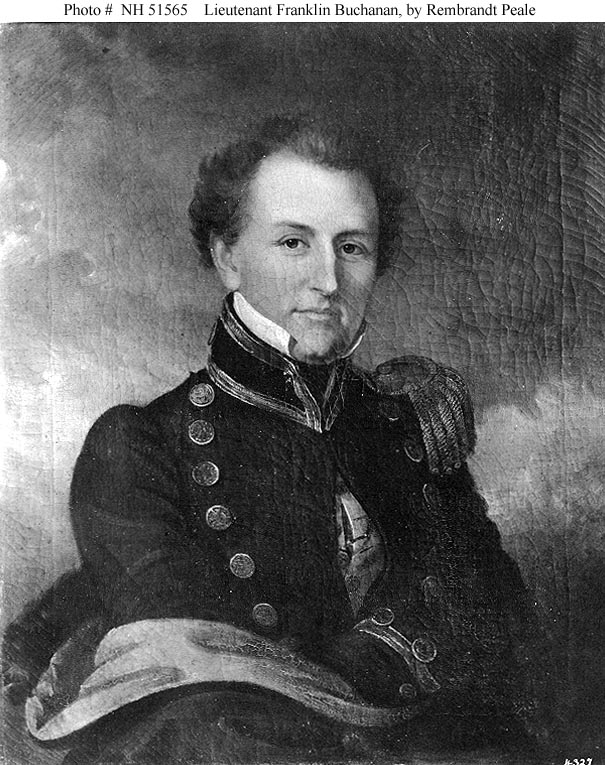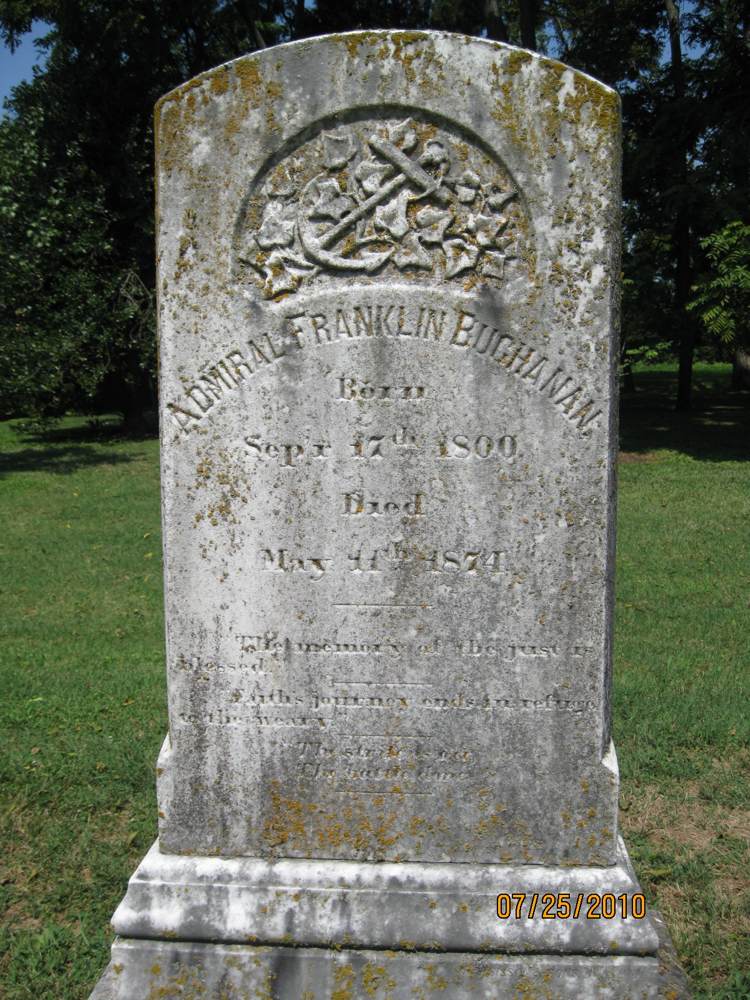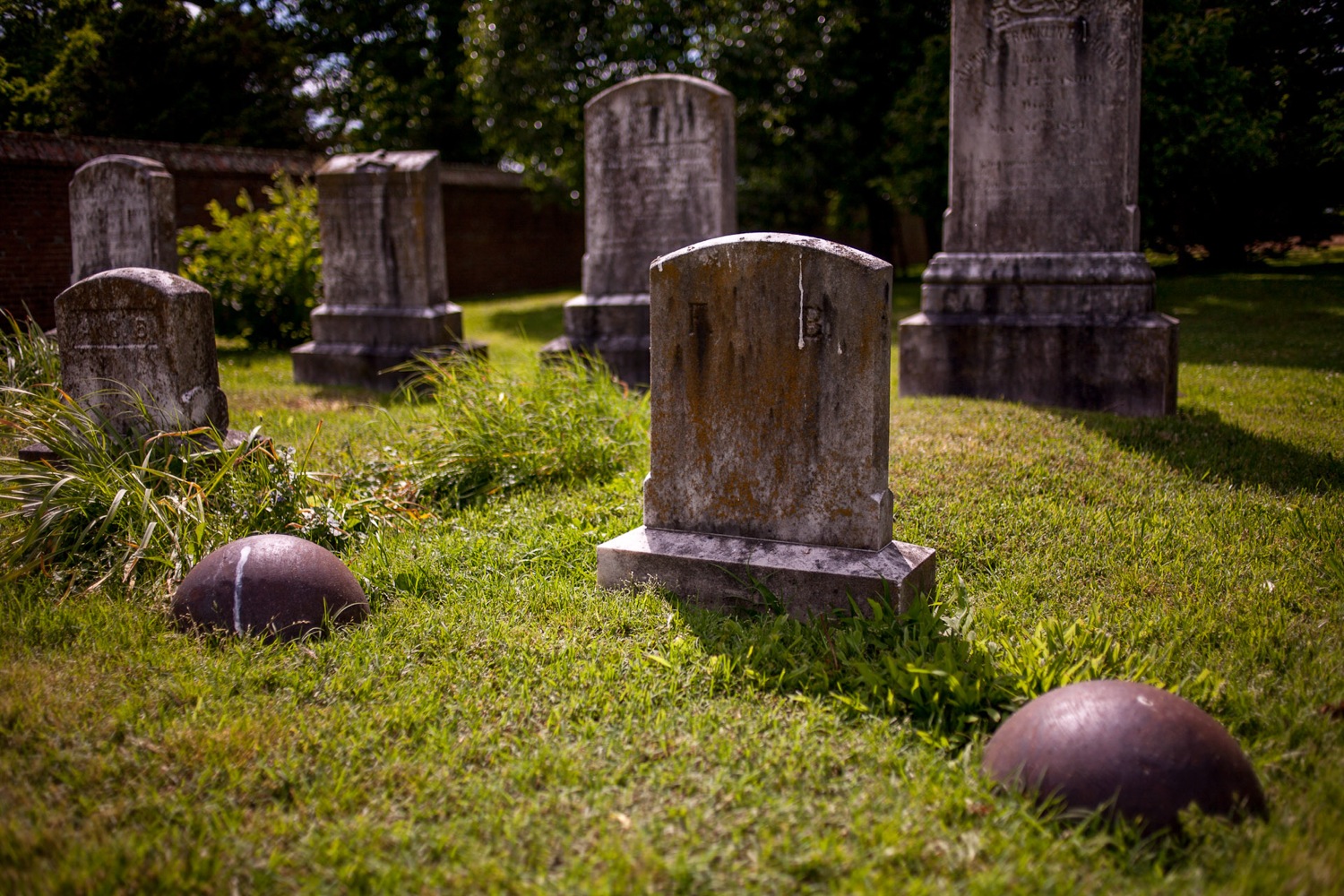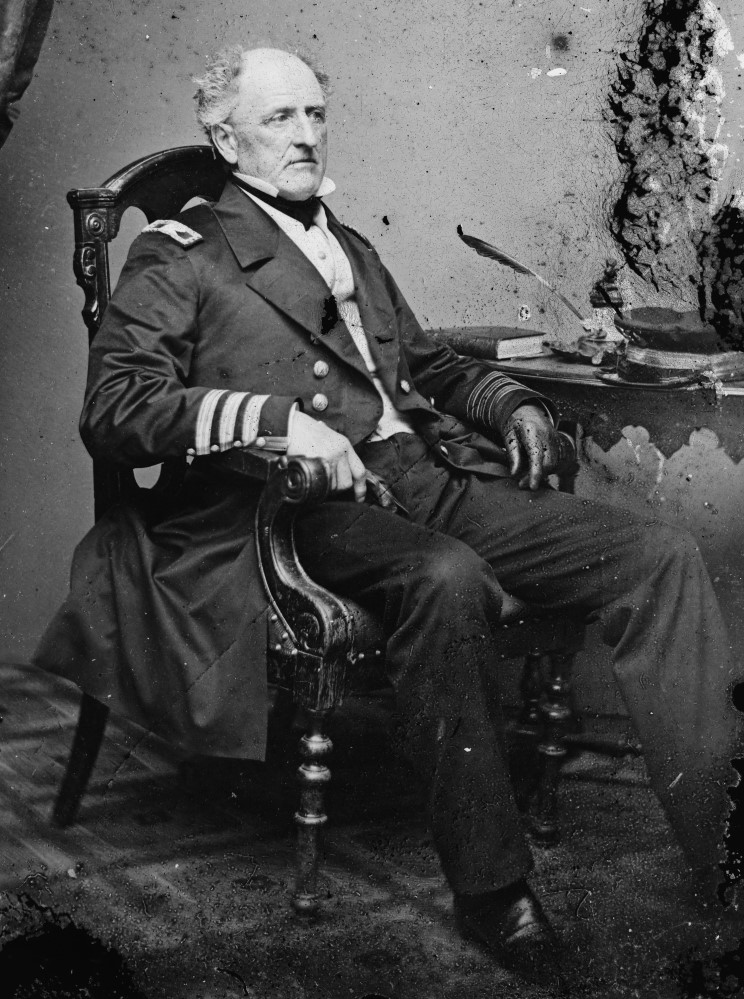Franklin Buchanan

Personal and Family Information
Franklin was born on 17 SEP 1800 in Pikesville, Baltimore, Maryland, the son of George Buchanan and Letitia McKean.
He died on 11 MAY 1874 in Pikesville, Baltimore, Maryland.
His wife was Ann Catherine Lloyd, who he married on 26 FEB 1835 in Annapolis, Anne Arundel County, Maryland. Their nine known children were Sallie Lloyd (1836-?), Letitia McKean (1837-1917), Alicia Lloyd (1838-1915), Ellen (1841-1922), Nannie (1841->1920), Elizabeth Tayloe (1845-?), Franklin (1847-1891), Rosa (1850-1893) and Mary Tilghman (1852-?).
Pedigree Chart (3 generations)
Events
| Event | Date | Details | Source | Multimedia | Notes |
|---|
| Birth | 17 SEP 1800 |
| Place: | Pikesville, Baltimore, Maryland |
| Type: | gravestone |
|
|
|
|
| Death | 11 MAY 1874 |
| Place: | Pikesville, Baltimore, Maryland |
| Age: | 73y 7m 24d |
| Address: | wye House, gravestone #5 |
|
Cemetery - Lloyd Family at Wye House
with marker inscriptions and arrangement drawing
| Source: | Cemetery - Lloyd Family at Wye House
with marker inscriptions and arrangement drawing |
|---|
| Date: | JUN 2012 |
|---|
| Publisher: | Arthur Bowie
Bentonville, Ark
http://www.bookofbowie.net/Cemtry/Lloyd.html |
|---|
|
|
|
| Census | 6 JUL 1860 |
| Place: | Washington, D.C. |
| Age: | 59 born Md |
| Address: | with wife, 9 children and 3 servants
dwelling 776 family 1000
Washington Ward 6 |
|
Census 1860 Washington, District of Columbia
| Source: | Census 1860 Washington, District of Columbia |
|---|
| Date: | 6 JUL 1860 |
|---|
|
|
|
| Burial | MAY 1874 |
| Place: | Lloyd Family Cemetery |
| Address: | Grave 5
N 38° 51.273’ W076° 10.078’
Easton, Talbot County, Md
http://www.bookofbowie.net/Cemtry/Lloyd.html |
| Agency: | Inventory of Cemetery, Wye House, Easton Md |
|
Cemetery - Lloyd Family at Wye House
with marker inscriptions and arrangement drawing
| Source: | Cemetery - Lloyd Family at Wye House
with marker inscriptions and arrangement drawing |
|---|
| Date: | JUN 2012 |
|---|
| Publisher: | Arthur Bowie
Bentonville, Ark
http://www.bookofbowie.net/Cemtry/Lloyd.html |
|---|
|
Gravestone 5 Inscription
Grave 5 with canon balls
|
See Note 2 |
| Other Event | 4 APR 1815 |
| Place: | Battle of Lake Erie |
| Type: | Military Service |
| Address: | frigate Jave
under command of Captain Oliver Perry
http://www.history.navy.mil/photos/pers-us/uspers-b/f-buchan.htm |
|
|
|
See Note 3 |
Attributes
| Attribute | Date | Description | Details | Source | Multimedia | Notes |
|---|
| Occupation | 3 SEP 1845 | First Superintendent of the Naval Academy at Annapolis |
| Place: | Annapolis, Anne Arundel County, Maryland |
| Address: | http://en.wikipedia.org/wiki/List_of_Superintendents_of_the_United_States_Naval_Academy |
|
|
|
|
| Occupation | AFT 1867 | President of what is now University of Maryland |
|
|
|
|
Multimedia
Notes
Note 1
DEPARTMENT OF THE NAVY -- NAVAL HISTORICAL CENTER
805 KIDDER BREESE SE -- WASHINGTON NAVY YARD WASHINGTON DC 20374-5060
http://www.history.navy.mil/photos/pers-us/uspers-b/f-buchan.htm
Admiral Franklin Buchanan, Confederate States Navy, (1800-1874)
Franklin Buchanan was born in Baltimore, Maryland, on 13 September 1800. He became a U.S. Navy Midshipman in 1815, was promoted to Lieutenant in 1825, to Commander in 1841 and to Captain in 1855. Over the four and a half decades of his U.S. Navy service, Buchanan had extensive and worldwide sea duty. He commanded the sloops of war Vincennes and Germantown during the 1840s and the steam frigate Susquehanna in the Perry expedition to Japan during the 1850s. In 1845-47, he served as the first Superintendent of the U.S. Naval Academy, followed by notable Mexican War service. In 1859-61, Captain Buchanan was the Commandant of the Washington Navy Yard.
Believing that his native state would soon leave the Union, Buchanan resigned his commission in April 1862. When Maryland did not secede, he tried to withdraw the resignation. Rebuffed by the Navy Department, which dismissed him from the service in May, he joined the Confederate States Navy, receiving a Captain's commission in September 1861. After heading the CSN's Office of Orders and Detail, Buchanan was placed in command of the defenses of the James River, Virginia. He led the pioneer ironclad Virginia in her successful attack on the Federal warships Cumberland and Congress in Hampton Roads on 8 March 1862, but was wounded in the action and had to leave the ship before her battle with USS Monitor on the following day.
In August 1862, Buchanan was promoted to the rank of Admiral and sent to command Confederate Navy forces on Mobile Bay, Alabama. He oversaw the construction of the ironclad CSS Tennessee and was on board her during her gallant battle with Rear Admiral David Glasgow Farragut's Union fleet on 5 August 1864. Wounded and taken prisoner, Admiral Buchanan was not exchanged until February 1865. He was on convalescent leave until the Civil War ended a few months later. Following the conflict, Buchanan lived in Maryland, then was a businessman in Mobile until 1870, when he again took up residence in Maryland. He died there on 11 May 1874.
Three U.S. Navy destroyers have been named in honor of Admiral Franklin Buchanan, including Buchanan (DD-131), Buchanan (DD-484) and Buchanan (DDG-14).
This page features all our pictures of Admiral Franklin Buchanan, CSN.
http://www.history.navy.mil/photos/pers-us/uspers-b/f-buchan.htm
http://cssvirginia.org/vacsn3/crew/virginia/buchanan.htm
Franklin Buchanan was a native of Maryland, but was appointed to the Navy from Pennsylvania, entering on January 28, 1815. A well-respected officer, he helped establish the Naval Academy at Annapolis and was its first president until he resigned to be on active duty in the Mexican War.
In 1861, he was number 47 on the list of USN Captains, and was the Commandant of the Washington Navy Yard. but resigned his commission in the U.S. Navy in expectation that his native state of Maryland would secede. When this failed to materialize, he applied for reinstatement but was refused with concerns about his loyalty. In his early days with the Confederacy, some Southerners also questioned his loyalty because of his attempt to rejoin the US Navy.
However, Buchanan had the respect of the Confederate Secretary of the Navy, Stephen Mallory. When Mallory needed the best officer to command the new, promising, but experimental, iron-clad CSS Virginia, he knew he wanted Buchanan. However, a strict seniority system prevailed and Buchanan could never be assigned as Captain of the most prized ship in the CS Navy as other, more senior, officers would demand the position. Instead, Mallory appointed Buchanan as Flag-Officer of the James River Squadron. Later, when the Virginia was completed, Buchanan naturally chose it as his flagship and assumed command of her. The Virginia never had a Captain appointed to her.
Buchanan was a bold commander, as were all the top commanders of the day. This trait was evidenced by his decision to turn the "trial trip" of the Virginia into her first combat. He alerted the Captains of his squadron but did not inform his crew until they were underway. This secrecy led to the complete surprise of the Union ships on a Saturday morning, although they had known the Virginia might come out at any time.
Buchanan did not cautiously test this untried ship. He immediately sailed past the broadsides one of the strongest of the Union fleet and rammed the USS Cumberland. With that success, he turned to destroy the Congress. Of the four ships that sailed to come to the aid of the Congress and Cumberland, three returned quickly to the safety of Fort Monroe while the fourth was helplessly aground. The Congress, having seen what happened to the Cumberland, tried to avoid being sunk by deliberately being towed aground. But the impregnable Virginia riddled the Congress until she surrendered.
This bold and utterly dominating attack left the Union Navy and Government in panic. Word was sent to the major ports such as Washington, Boston, and New York to prepare to blockade their entrances by sinking barges of rocks. Members of Lincoln's cabinet expected the Virginia to sail up and bombard the Capitol.
After the Congress surrendered, Buchanan ordered the capture of her officers, the rescue of the wounded, and directed that the others be allowed to escape overboard (an easy swim to shore). After all were off, the Congress was to be set afire as she was aground in an enemy-controlled area and could not be easily towed away. While the Beaufort attempted to carry out these orders and had some of the wounded on board, the Union troops opened fire on her, killing a number of Union sailors and some Confederate sailors. The Beaufort withdrew but Buchanan did not even conceive of what had happened. He sent his Flag Lieutenant, Minor, to set fire to the Congress. When he saw the troops fire on the small boat despite the white flag flying from the Congress, he was incensed. Unwisely, he started firing a musket towards the shore positions from the top deck of the Virginia. A minie-ball hit him in the leg near the femoral artery. After being wounded, he ordered hot shot to destroy the Congress by fire and for his Executive Officer, Catesby ap Roger Jones, to take command. Buchanan did this even knowing that his brother, McKean Buchanan, was paymaster on the Congress.
Buchanan was removed to the Naval Hospital on the Elizabeth River the next morning where he spent the next few months(?) recovering from his wounds. He eventually recovered and had other commands in the Confederacy. After the Battle of Hampton Roads, no Southerner ever doubted his loyalty, and he was promoted to Admiral. On August 5, 1864, he commanded the Tennessee and the fleet in Mobile Bay. He wounds were severe enough that his leg had to be amputated.
Note 2
The memory of the just is blessed
Faith's journey ends in refuge to the weary.
the strife iso'er
The battle won
At foot of grave are two cannon balls Buchanan took as souvenirs in 1847 from Mexican city of Alvarado in the Mexican -American War. see page 8 of Bio.
Note 3
Commanding officer of Commander Perry;s flagship Susquehanna when Perry opened Japan to American commerce by treaty in 1853.
Also rendered distinguished service in the Mexican War.
Commanded Confederate shi Virginia, generally known as the Merrimac, in her first days action when he was wounded. The famous encounter between the Monitor and the Merrimac was fought the next day with Lt Catesby Jones commanding.
Buchanan later commanded a hopelessly weak Confederate squadron in the Battle of Mobile Bay.
Sources
- Census 1860 Washington, District of Columbia
| Source: | Census 1860 Washington, District of Columbia |
|---|
| Date: | 6 JUL 1860 |
|---|
- Cemetery - Lloyd Family at Wye House
with marker inscriptions and arrangement drawing
| Source: | Cemetery - Lloyd Family at Wye House
with marker inscriptions and arrangement drawing |
|---|
| Date: | JUN 2012 |
|---|
| Publisher: | Arthur Bowie
Bentonville, Ark
http://www.bookofbowie.net/Cemtry/Lloyd.html |
|---|
- Cemetery - Lloyd Family at Wye House
with marker inscriptions and arrangement drawing
| Source: | Cemetery - Lloyd Family at Wye House
with marker inscriptions and arrangement drawing |
|---|
| Date: | JUN 2012 |
|---|
| Publisher: | Arthur Bowie
Bentonville, Ark
http://www.bookofbowie.net/Cemtry/Lloyd.html |
|---|





